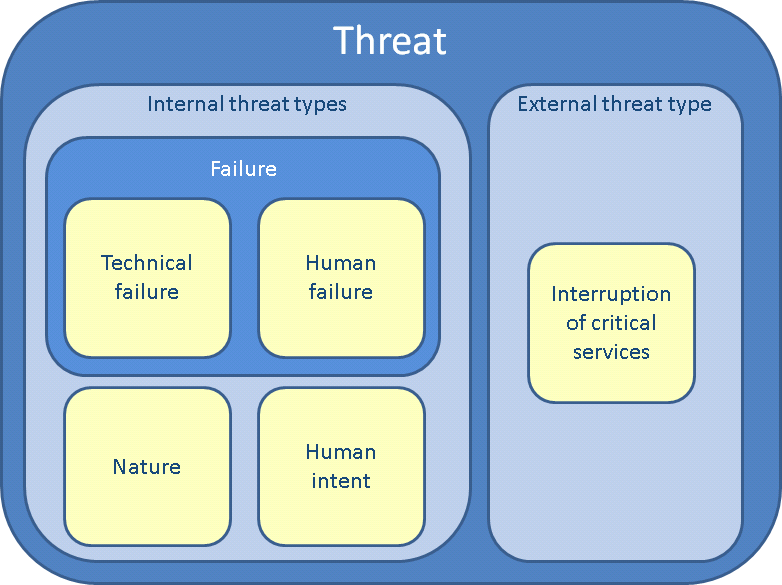Difference between revisions of "Safety threats"
m (Tijdelijk moved page Threat to Safety threats: To distinguish between safety threats and 'Security threats') |
|||
| (92 intermediate revisions by 6 users not shown) | |||
| Line 1: | Line 1: | ||
[[Category:Threat]] |
|||
=Introduction= |
|||
A threat is a source of potential harm. It can both originate in wilful act (such as the threat of violence), as in non-intentional circumstances (such as the threat of volcanic eruptions). |
|||
[[File:ae.png|25px|right|This is a page providing background in a specific field of expertise]]A threat is a source of potential harm <ref>"''An indication of possible violence, harm, or danger.''": DHS (2004): National Response Plan. Department of Homeland Security: Washington. Online: http://www.scd.hawaii.gov/documents/nrp.pdf [2011-03-23].</ref>. It includes [[security]] threats which originate in wilful act ([[human intent]], such as the threat of violence or [[Urban terrorism|terrorism]]), and [[Safety|safety threats]], which originate in non-intentional circumstances (such as the threat of [[Natural threat|natural hazards]], e.g. floodings, volcanic eruptions etc., or man-made hazards, e.g. industrial accidents or [[technical failure|technical failure]], [[human failure]]). |
|||
| ⚫ | |||
| ⚫ | |||
| ⚫ | |||
| ⚫ | Threats can in this perspective be classified by their origin. This classification is layered: the first layer discriminates between threats that have impact on the internal processes (such as a car hitting a building and causing diminished structural safety for the inhabitants) and threats that only have impact on external requirements for those processes (such as a discontinuation of electricity supply to a building). Both types of threats will result in diminished continuity or quality of functions provided by the building (reduced safety in the first example, reduced comfort in the second example). |
||
| ⚫ | When we look at the concept of threat from the perspective of its functional use (which we can also do for urban objects), a threat can be defined as any circumstance that threatens the continuity or quality of those [[function|functions]] (which include, amongst others, protection of life and economic use). |
||
| ⚫ | Threats can in this perspective be classified by their origin. This classification is layered: the first layer discriminates between internal threats that have impact on the internal processes (such as a car hitting a building and causing diminished structural safety for the inhabitants) and external threats that only have impact on external requirements for those processes (such as a discontinuation of electricity supply to a building). Both types of threats will result in diminished continuity or quality of functions provided by the building (reduced safety in the first example, reduced comfort in the second example). |
||
| ⚫ | Within internal threats we can distinguish threats that originate from natural processes, threats that originate from failures, and threats that originate in wilful acts. Within threats that originate from failure, we can again distinguish between failures of designs (technical failure) and failures of human action (human failure). This structure is graphically depicted in figure |
||
| ⚫ | Within internal threats we can distinguish threats that originate from [[natural threat|natural]] processes, threats that originate from failures, and threats that originate in [[human intent|wilful acts]]. Within threats that originate from failure, we can again distinguish between failures of designs ([[technical failure]]) and failures of human action ([[human failure]]). This structure is graphically depicted in the (clickable) figure below. |
||
[[File:taxonomy threats.png]] |
|||
<imagemap> |
|||
Image:Taxonomy_threats.png|500px|center |
|||
rect 64 201 228 358 [[Technical failure|technical failure]] |
|||
rect 256 200 424 355 [[Human failure|Human failure]] |
|||
rect 60 387 230 545 [[Natural threat|Natural threat]] |
|||
rect 255 389 425 545 [[Human intent|human intent]] |
|||
rect 527 242 696 404 [[Failure of critical services|failure of critical services]] |
|||
desc bottom-left |
|||
</imagemap> |
|||
{{references}} |
|||
Latest revision as of 10:55, 28 October 2020
A threat is a source of potential harm [1]. It includes security threats which originate in wilful act (human intent, such as the threat of violence or terrorism), and safety threats, which originate in non-intentional circumstances (such as the threat of natural hazards, e.g. floodings, volcanic eruptions etc., or man-made hazards, e.g. industrial accidents or technical failure, human failure).
Types of threat for functional objects
When we look at the concept of threat from the perspective of its functional use (which we can also do for urban objects), a threat can be defined as any circumstance that threatens the continuity or quality of those functions (which include, amongst others, protection of life and economic use).
Threats can in this perspective be classified by their origin. This classification is layered: the first layer discriminates between internal threats that have impact on the internal processes (such as a car hitting a building and causing diminished structural safety for the inhabitants) and external threats that only have impact on external requirements for those processes (such as a discontinuation of electricity supply to a building). Both types of threats will result in diminished continuity or quality of functions provided by the building (reduced safety in the first example, reduced comfort in the second example).
Within internal threats we can distinguish threats that originate from natural processes, threats that originate from failures, and threats that originate in wilful acts. Within threats that originate from failure, we can again distinguish between failures of designs (technical failure) and failures of human action (human failure). This structure is graphically depicted in the (clickable) figure below.
Footnotes and references
- ↑ "An indication of possible violence, harm, or danger.": DHS (2004): National Response Plan. Department of Homeland Security: Washington. Online: http://www.scd.hawaii.gov/documents/nrp.pdf [2011-03-23].

